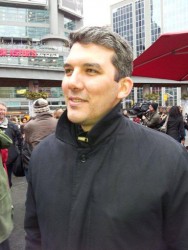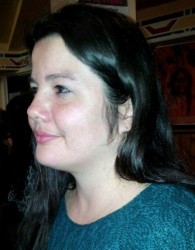Article Origin
Volume
Issue
Year
The Toronto Aboriginal community has not been idle. In the week leading up to the Jan. 11 meeting with the Prime Minister, many people were hard at work organizing events.
On Jan. 8, one of the two Toronto Idle No More groups held the first of scheduled weekly teach-ins at Toronto Council Fire. About 100 participants showed up and they reflected the diversity of Toronto’s multicultural population, as well as the diversity of the Aboriginal community in the city.
One by one they introduced themselves, identifying their cultural roots. Men and women of all ages with family origins in the Balkans, South Africa, Ireland, Scotland, Holland, India, Egypt, Poland, United Arab Emirates sat side by side with First Nations and Metis from Couchiching, Moose Factory, Serpent River and M’Chigeeng First Nations in Ontario, and communities in Manitoba, Saskatchewan and New Brunswick.
Artist and political activist Wanda Nanibush promised the group they would learn “a different story of Canada.” People shook their heads in disbelief as she gave a short history of the Indian Act, events leading to and resulting from the legislation, and some of the atrocities committed in the name of civilization. The next speaker, Hayden King from Beausoleil First Nation and assistant professor of Politics at Ryerson University, spoke about the history of Aboriginal resistance over the past 150 years, taking either diplomatic or provocative means to resisting legislation or encroachment of land.
The Northwest Rebellion, establishment of the League of Indians in 1923, the Red Power Movement and emergence of leaders like Harold Cardinal in response to the 1960s White Paper, the American Indian Movement, the Oka Crisis and various legal challenges were some instances of Aboriginal resistance that he discussed.
But Idle No More, King said, is “a moment in history that’s never occurred before.” It’s “a remarkable movement,” he said, that has inspired Indigenous people all over the world.
In spite of the damp and drizzly weather, hundreds of people converged at Toronto’s Dundas Square for the Flash Mob Round Dance on Jan. 11. A dozen or so female voices accompanied by drums rang out in the square, and spirits were high as people of all races and colors joined hands and round-danced in friendship and solidarity. A collective cheer erupted when Chief Theresa Spence appeared on the Jumbotron screen in the Square.
Loretta Schuster, a young Ojibway woman, said she is drawn to Idle No More because the Harper Bills threaten her fragile connection with her past and her heritage. She was adopted into a Catholic family and the traditional lands of her community, Lac des Mille Lacs First Nation in Northern Ontario, have already been destroyed by flooding and the people displaced.
“This happened to my reserve,” she said, “and it will happen to other people with these Bills.”
Alice Mathias, an Ojibway woman in her fifties, was at Dundas Square with a friend who was draped with the distinctive purple and white wampum flag.
“I never thought in my life I’d be participating in a protest,” she said, “but this is crucial.” Mathias whose roots are in Temagami grew up in foster homes. “Something like this, it’s an awakening,” she said. “People have to be out here. It stirs something in their soul.” Mathias hopes these events will “show the government there is a strong voice and they can no longer ignore us.”
Jeffrey McNeil, from Kamloops Indian Band in B.C., believes Idle No More is about bringing people of many ethnic backgrounds into the circle.
“It’s happened. Things have already changed,” he said. “There’s been an explosion not just on Turtle Island, but around the globe. How we relate to the land and each other, the underlying racism, that conversation needs to continue to be at the forefront.”
On the evening of the Jan. 11, a group art show opened at the Gerrard Art Space Gallery (GAS) featuring work by 36-year old photographer Jason Jenkins. The show was coordinated by NABET, the union representing Toronto’s film and video technicians.
Jenkins who is of Ojibway, African and French heritage is a NABET member and he has been photographing Idle No More events. The photographs are of Flash Mob Round Dances at Toronto’s Eaton Centre and Dundas Square and show the sheer size of the crowds, the individual intensity and concentration of the singers, and the spirit of celebration on the faces of the people round dancing.
Jenkins was prompted to enter the show, he said; “to have another venue to continue the conversation with a different audience. Hopefully, they’ll start to ask what Idle No More is about and it’ll get them involved.”
He said the movement is an awakening for the community, but it’s also proven to be a personal creative awakening for him.
“For the last couple of years,” he said, “I’ve worked for other people, putting my own creative ideas on the back burner. That’s changed with all the stuff that’s happening now.”
- 11558 views


